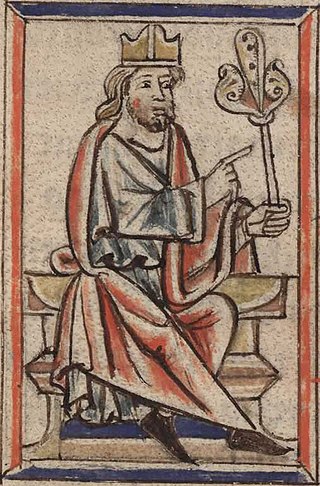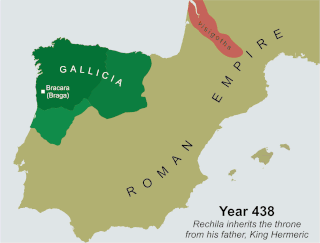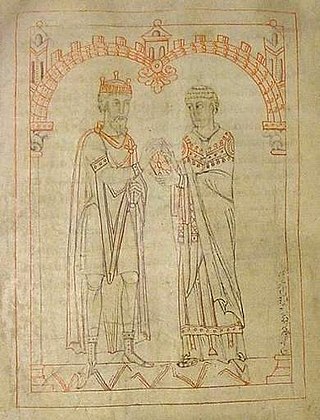
The Suebi were a large group of Germanic peoples originally from the Elbe river region in what is now Germany and the Czech Republic. In the early Roman era they included many peoples with their own names such as the Marcomanni, Quadi, Hermunduri, Semnones, and Lombards. New groupings formed later, such as the Alamanni and Bavarians, and two kingdoms in the Migration Period were simply referred to as Suebian.

Reccared I was the king of the Visigoths, ruling in Hispania, Gallaecia and Septimania. His reign marked a climactic shift in history, with the king's renunciation of Arianism in favour of Roman Christianity in 587.
This is a historical timeline of the Iberian Peninsula during the period of the post-Imperial kingdoms.

Hermeric was the king of the Suevi from at least 419 and possibly as early as 406 until his abdication in 438.

Chintila was a Visigothic King of Hispania, Septimania and Galicia from 636. He succeeded Sisenand and reigned until he died of natural causes, ruling over the fifth and sixth provisional Councils of Toledo. He wrote poetry as well. He was succeeded by his son from an unknown wife, Tulga.

The Iberian Peninsula, where Galicia is located, has been inhabited for at least 500,000 years, first by Neanderthals and then by modern humans. From about 4500 BC, it was inhabited by a megalithic culture, which entered the Bronze Age about 1500 BC. These people would become the Gallaeci, and they would be conquered by the Roman Empire in the first and second centuries AD. As the Roman Empire declined, Galicia would be conquered and ruled by various Germanic tribes, notably the Suebi and Visigoths, until the 9th century. Then the Muslim conquest of Iberia reached Galicia, although they never quite controlled the area.

Rechila was the Suevic king of Galicia from 438 until his death. There are few primary sources for his life, but Hydatius was a contemporary Christian (non-Arian) chronicler in Galicia.

Rechiar or Flavius Rechiarius was the third Suevic king of Gallaecia, from 448 until his death, and also the first one to be born in Gallaecia. He was one of the most innovative and belligerent of the Suevi monarchs. Hydatius, the contemporary bishop and chronicler from Galicia who is the sole contemporary source for biographical details of Rechiar, established his reputation as that of a barbarian with little sense of Roman law, culture, or custom; accusations already discredited, but very common at that time.

The Kingdom of the Suebi, also called the Kingdom of Galicia or Suebi Kingdom of Galicia, was a Germanic post-Roman kingdom that was one of the first to separate from the Roman Empire. Based in the former Roman provinces of Gallaecia and northern Lusitania, the de facto kingdom was established by the Suebi about 409, and during the 6th century it became a formally declared kingdom identifying with Gallaecia. It maintained its independence until 585, when it was annexed by the Visigoths, and was turned into the sixth province of the Visigothic Kingdom in Hispania.
Aioulf or Ag(r)iwulf was an obscure king of Galicia from 456. In 448, after eight years in captivity, the Roman ambassador Censorius was executed by one Agiulf at Seville (Hispalis). This Agiulf has sometimes been identified with Aioulf.
Chararic or Chararich was the King of Galicia according to Gregory of Tours, who is the only primary source for a Suevic king of this name.

Theodemir or Theodemar was one of the last Suevic kings of Galicia and one of the first Chalcedonian Christians to hold the title. He succeeded Ariamir sometime between the end of May 561 and the year 566 and ruled until his death.

Miro was the Suebian King of Galicia from 570 until his death in 583. His reign was marked by attempts to forge alliances with other Chalcedonian Christian nations with the goal of checking the power of the Arian Visigoths under Leovigild. During his reign relations were established with both Francia and the Byzantine Empire and the kingdom reached its zenith, but it collapsed within three years of his death.

Fructuosus of Braga was the Bishop of Dumio and Archbishop of Braga, also known for being a great founder of monasteries The son of a Visigothic dux in the region of Bierzo, at a young age he accompanied his father on official trips over his estates. After a period spent as a hermit, he established a monastery at Complutum and became its first abbot.

Saint Martin of Braga, also known as Saint Martin of Dumio, was an archbishop of Bracara Augusta in Gallaecia, a missionary, a monastic founder, and an ecclesiastical author. According to his contemporary, the historian Gregory of Tours, Martin was plenus virtutibus and in tantum se litteris imbuit ut nulli secundus sui temporis haberetur. He was later canonized by the Catholic Church for his work in converting the inhabitants of Gallaecia to Chalcedonian Christianity, being granted the cognomen of "Apostle to the Suevi". His feast day is 20 March.

Ariamir was the Suevic King of Galicia, with his capital at Bracara, from 558/9. The bishops of the First Council of Braga recorded Ariamir as the king who summoned them and under whose auspices they deliberated. Because the bishops mention theirs as being the first Nicene synod to be held in Galicia in a long while, Ariamir is sometimes assumed to have been the king who led the conversion of his people from Arianism to orthodoxy and thus to have lifted the ban on Nicene councils.
Veremund or Veremundus was a Suevic king of Galicia around 500. His existence is conjectured on the basis of a sixth-century inscription discovered at Salvador de Vairão. The date in the inscription is interpreted as either 485 or 535. Some scholars have dated the inscription to the eighth century, arguing that the Veremundus of the inscription is King Bermudo I of Asturias.

In the First Council of Braga, held in 561 in the city of Braga, eight bishops took part, and twenty-two decrees were promulgated. In a number of canons, the council took aim directly at doctrines of Priscillianism.
The Ruccones were a tribal group, probably related to the Astures or the Basques, who lived semi-autonomously in northern Hispania from the fifth through to the seventh centuries. Their population area extended approximately from modern-day Asturias to La Rioja.
Suniefred was a Visigothic nobleman who rebelled during the reign of Egica and briefly ruled as king from Toledo.












